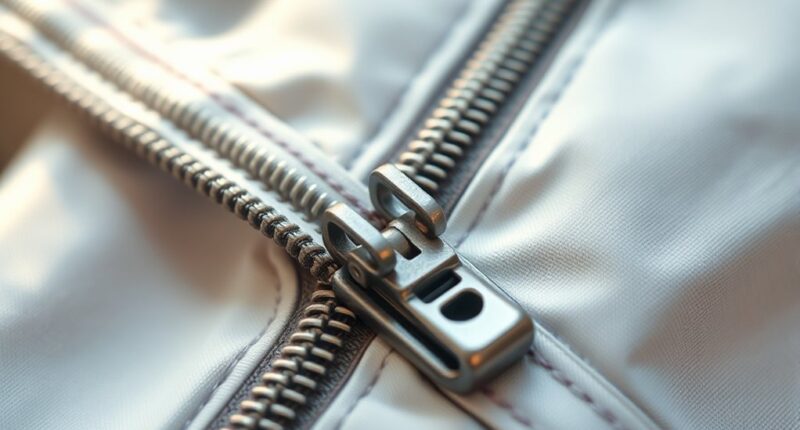Many people assume that cleaning zippers and covers is simple, but common mistakes like using harsh chemicals, ignoring maintenance, or not verifying waterproof claims can cause damage and shorten their lifespan. Overloading machines or skipping protective treatments also lead to costly repairs. Believing covers are always machine washable or that all zippers resist water can misguide you. Stay aware of these errors, and you’ll find out how proper care makes all the difference.
Key Takeaways
- Proper cleaning depends on understanding material-specific care labels and avoiding harsh chemicals or high heat.
- Regular inspections and prompt repairs prevent minor zipper or fabric issues from escalating.
- Not all waterproof claims are verified; testing ensures zippers and covers truly resist moisture.
- Overloading washing machines or drying improperly causes uneven cleaning and damages fabrics and zippers.
- Proper storage—cool, dry, and out of sunlight—significantly extends the lifespan of covers and their zippers.
Using Harsh Chemicals to Clean Zippers and Covers
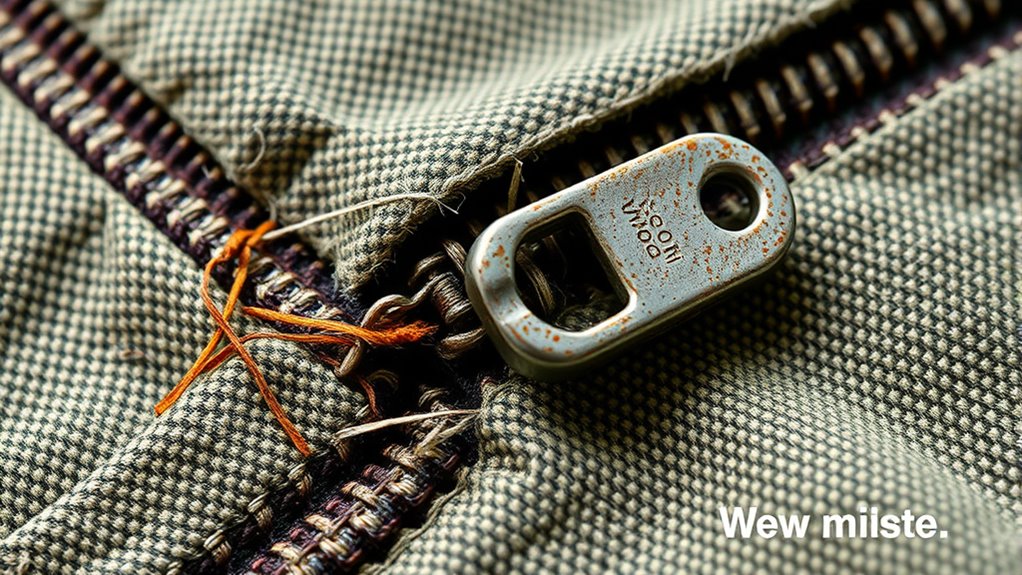
Using harsh chemicals to clean zippers and covers can do more harm than good. Chemical cleaning with harsh detergents might seem effective initially, but it often damages delicate fabrics and metal parts. These strong chemicals can weaken the material, leading to tears or corrosion over time. Zippers, especially, are sensitive to aggressive cleaning agents that can strip protective coatings or cause rust. Instead, opt for gentle cleaning methods, like mild soap and water, to preserve their integrity. Regularly inspect and clean your zippers and covers with safer products to extend their lifespan. Remember, aggressive chemical cleaning might save time in the short term, but it risks costly repairs or replacements later on. Protect your gear by choosing safe, effective cleaning routines.
Ignoring Regular Maintenance and Inspections

Ignoring early warning signs or skipping regular inspections can lead to bigger problems down the line. When you delay professional checks, small issues may worsen, making repairs more costly and time-consuming. Staying proactive helps keep your zipper and cover in top shape and prevents unnecessary damage.
Neglecting Early Signs
Failing to recognize early signs of zipper or cover issues can lead to costly repairs and prolonged downtime. When you ignore minor problems like slight fraying, misalignment, or unusual noises, you miss opportunities for early detection. Addressing issues promptly through proactive maintenance prevents small issues from escalating into major failures. Regularly inspecting your equipment allows you to spot early warning signs before they become serious. Being aware of emotional support options can also help you manage stress associated with equipment issues and maintenance challenges. By staying vigilant and acting quickly, you extend the lifespan of your zipper and cover, saving money and reducing disruptions. Remember, preventative care isn’t just about fixing problems—it’s about catching them early and maintaining ideal performance. Prioritize routine checks and stay attentive to early signs to keep your equipment functioning smoothly and avoid unnecessary expenses.
Delaying Professional Checks
Overlooking regular maintenance and inspections can turn small zipper or cover issues into major failures. When you delay professional inspections, minor problems like loose teeth or worn fabric can escalate, leading to costly repairs or replacements. Timely assessments by experts catch issues early, preventing further damage and ensuring your zipper and cover remain functional. Skipping these checks may seem convenient, but it risks unexpected breakdowns that disrupt your use and increase expenses. Regular professional inspections provide peace of mind, helping you identify wear and tear before it worsens. Proper projector maintenance starts with routine assessments to maintain your zipper and cover’s longevity, saving you time and money in the long run. Don’t wait until a small problem becomes a crisis. Schedule routine assessments to maintain your zipper and cover’s longevity, saving you time and money in the long run. Proper care starts with consistent, proactive inspections.
Assuming All Zippers Are Waterproof Without Verification
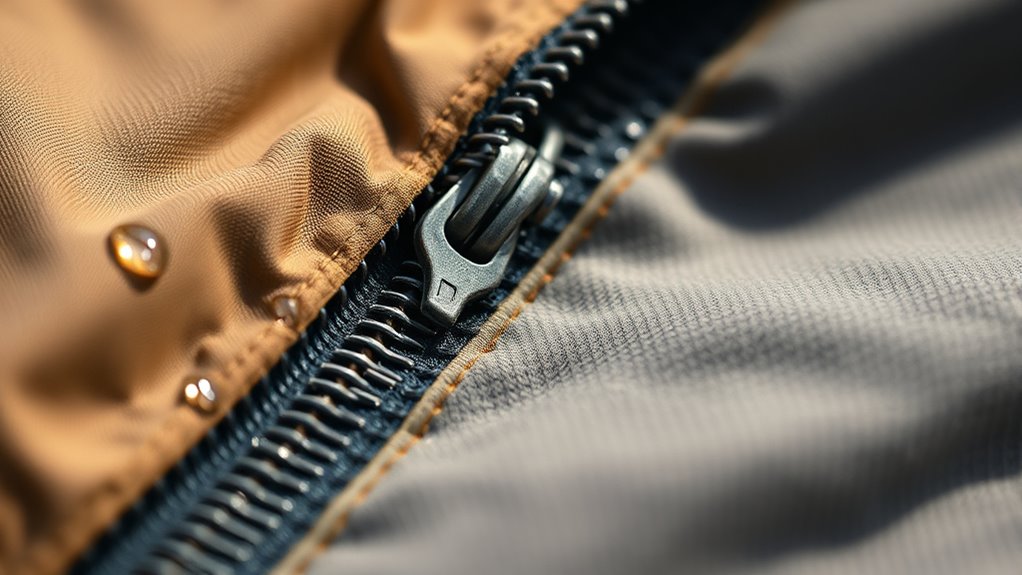
While it might seem convenient to assume all zippers are waterproof, this can lead to costly mistakes if you depend on them without verification. Many believe that a zipper’s appearance or brand guarantees waterproofing, but that’s not always true. Waterproof assumptions can cause you to underestimate the need for proper testing or specialized seals. Verification importance becomes clear when you consider potential leaks or damage during heavy rain or moisture exposure. Not all zippers are designed to withstand water pressure, so taking the extra step to confirm waterproof features prevents surprises later. Always check product specifications or perform a simple test before trusting a zipper’s waterproof claim. Conducting a drip test can help determine if a zipper truly resists water penetration. Relying on verified information ensures your gear stays dry and performs as expected.
Overlooking the Importance of Proper Lubrication

Ignoring proper lubrication can cause your zipper to jam or wear out quickly. Choosing the right lubricant and applying it regularly keeps everything moving smoothly. Don’t overlook this simple step; it makes a big difference in your gear’s longevity.
Lubricant Types Matter
Choosing the right lubricant is essential for maintaining zipper and cover functionality, yet many overlook its importance. Using the correct type of lubricant ensures smooth zipper operation and effective cover conditioning. Not all lubricants are suitable; some can cause damage or attract dirt. Here are key points to consider:
- Silicone-based lubricants are ideal for zipper lubrication because they provide long-lasting, smooth movement without residue buildup.
- Dry lubricants, like graphite, are excellent for outdoor covers, as they resist dirt and moisture.
- Avoid oil-based lubricants for covers—they can stain fabrics and degrade materials over time.
- Proper lubrication can also prevent wear and tear, extending the lifespan of zippers and covers significantly.
Selecting the appropriate lubricant type enhances longevity and performance, making your zipper and cover maintenance more effective and less troublesome.
Regular Application Benefits
Regularly applying the right lubricant keeps your zipper and covers functioning smoothly and prevents issues before they arise. Proper lubrication helps maintain zipper alignment, reducing the risk of jamming or misalignment that can damage the teeth. It also preserves the cover color by minimizing friction that causes fading or wear. When you keep the zipper well-lubricated, you’ll notice easier operation and fewer snags, saving you time and effort. Consistent application ensures the lubricant penetrates effectively, extending the lifespan of both zipper and cover. Neglecting this step can lead to stiff, stuck zippers and dull, discolored covers. Regular maintenance also supports overall tuning of your gear, ensuring optimal performance and longevity. By making lubrication a routine part of your care, you protect your investment and keep your covers looking fresh and functioning flawlessly.
Believing That Washing a Cover Will Always Remove All Stains
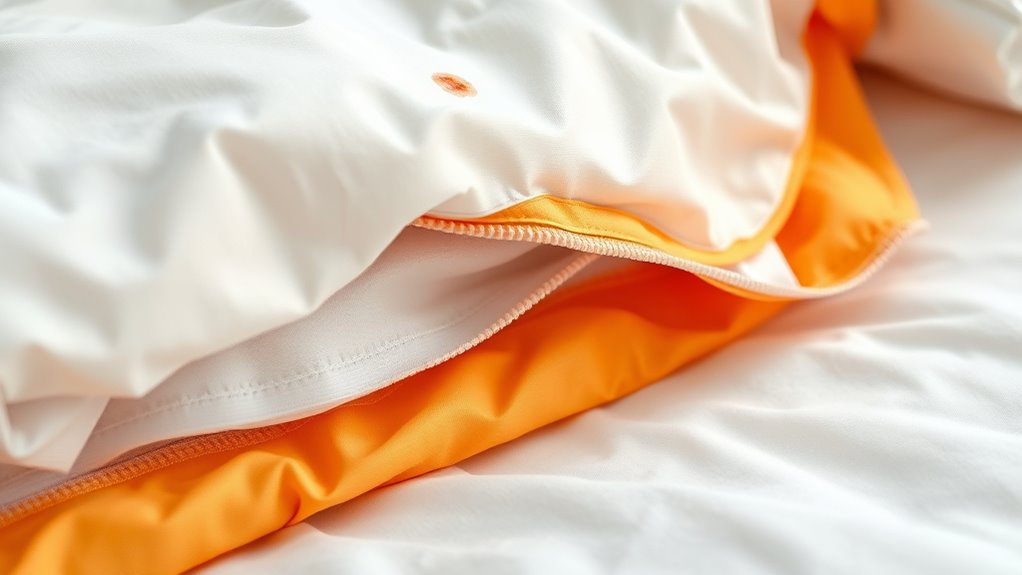
Many people assume that washing a cover will always eliminate all stains, but this isn’t always the case. The effectiveness of stain removal depends on the cover material and the type of stain. Some stains, like oil or dye, can set deep into the fabric if not treated promptly. Simply throwing the cover in the wash isn’t enough for tough stains.
Here are three tips to improve stain removal:
- Identify the stain type to choose the right cleaning method.
- Pre-treat stains with appropriate stain removers before washing.
- Use the correct water temperature and cycle for your cover material.
Forgetting to Test Cleaning Products on a Small Area First
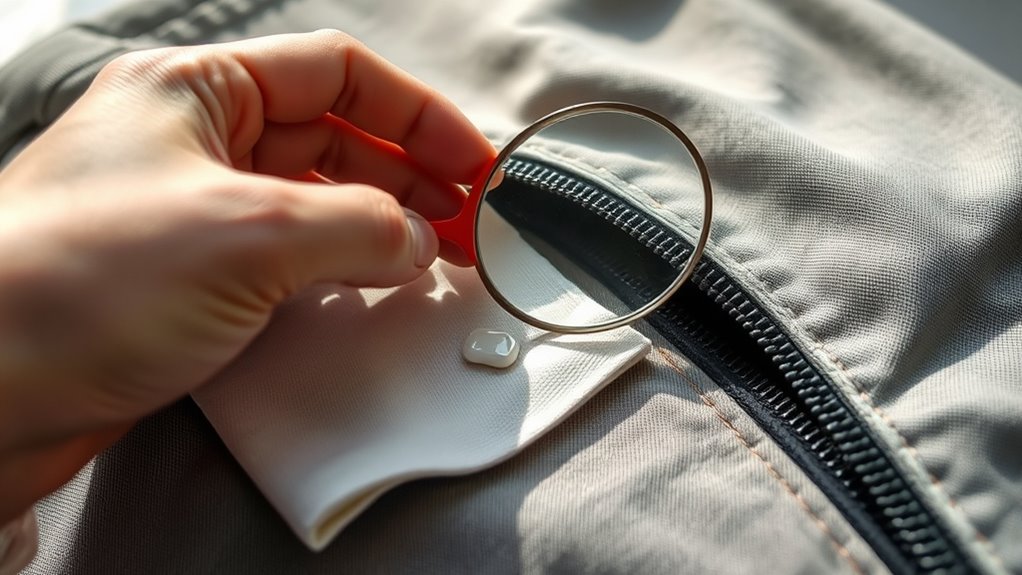
Even if you’ve identified the right stain removal method and pre-treated your cover, skipping a patch test can lead to unexpected damage. Always test cleaning products on a small, hidden area first. This step helps you avoid cover color fading or fabric damage. Use a discreet spot like the inside corner or seam. Proper cover maintenance depends on understanding how different cleaning agents affect your specific material.
Using High Heat When Drying or Ironing Covers
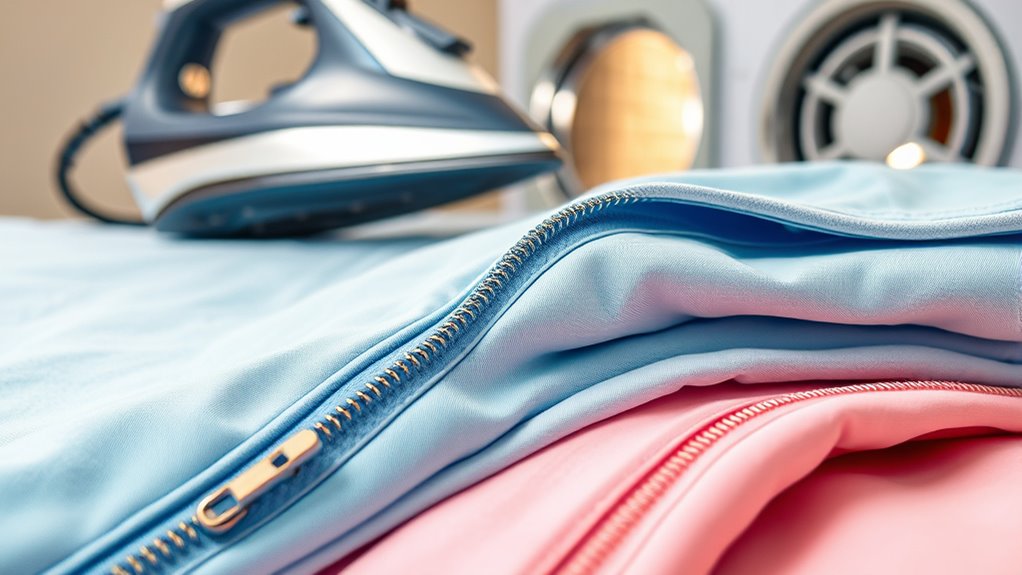
Using high heat when drying or ironing covers can cause damage to delicate fabrics and fade colors over time. It also risks melting zippers or weakening their functionality. To keep your covers looking and working their best, it’s vital to take into account the material and heat settings carefully. Additionally, choosing the appropriate filter type can help maintain the integrity of your covers and prevent unnecessary wear.
Cover Material Damage
Have you ever damaged a cover by exposing it to high heat during drying or ironing? High heat can cause material deterioration, accelerating cover aging and reducing its lifespan. To avoid this, keep these tips in mind:
- Never use high heat settings on dryers or irons. Instead, opt for low or delicate cycles.
- Always check the care label for specific heat instructions.
- Use a cloth or towel between the iron and the cover if you need to smooth out wrinkles.
- Remember, using natural materials like linen on covers can help prevent heat damage and prolong durability.
Exposing covers to excessive heat weakens fibers and can lead to cracks, tears, or warping. Proper heat management preserves the integrity of your cover, extending its lifespan and keeping it looking fresh longer.
Zipper Meltdown Risks
Exposing zipper components to high heat during drying or ironing can cause them to melt, warp, or become brittle. This poses a serious zipper safety risk and can considerably reduce your cover’s durability. When zippers are exposed to intense heat, the plastic or metal parts may deform, making zipping difficult or impossible. Ironing covers at high temperatures can also transfer heat to the zipper, weakening its structure over time. To protect your investment, always follow care instructions carefully and avoid using high heat on covers with zippers. Proper care ensures the zipper remains functional and maintains the overall integrity of your cover. Additionally, vacuums for luxury vinyl plank floors are designed to be gentle and protect delicate surfaces from damage, highlighting the importance of proper cleaning and maintenance practices. Remember, safeguarding zipper safety isn’t just about avoiding damage — it’s about preserving the longevity and performance of your entire cover.
Color Fading Issues
High heat during drying or ironing can cause your cover’s colors to fade quickly. To maintain color preservation and dye stability, avoid using high temperatures. Here are three tips to prevent color fading:
- Use a low or tumble-dry setting to protect vibrant hues.
- Always opt for a cool iron, or better yet, avoid ironing altogether.
- Wash covers inside out to reduce direct heat and friction that weaken dyes.
- Be mindful of color fading issues, as exposure to heat can accelerate dye loss and diminish your cover’s appearance over time.
Not Recognizing Signs of Wear and Tear Early On
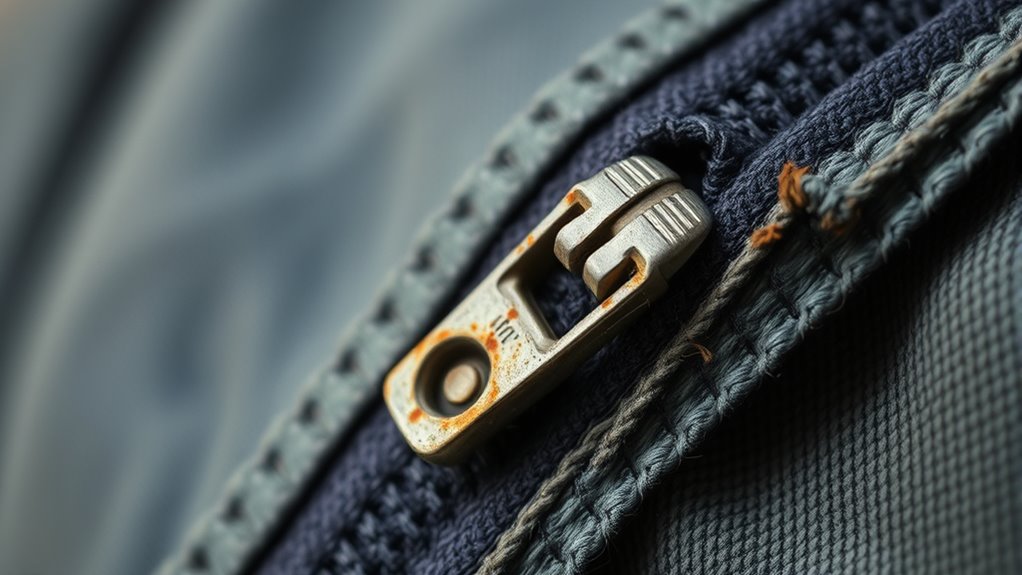
Recognizing early signs of wear and tear on zippers and covers can save you time and money in the long run. If you ignore the early indicators, small issues can escalate into major problems that require costly repairs or replacements. Look out for frayed fabric, loose threads, or a zipper that’s starting to stick or catch. These are clear signs of wear and tear that shouldn’t be overlooked. Catching these issues early allows you to address them before they worsen, preserving the lifespan of your cover and zipper. Regular inspections can help you spot subtle damage before it becomes a bigger concern. Paying attention to these early indicators ensures you maintain your covers properly and avoid unnecessary expenses down the line.
Assuming Zippers Cannot Be Repaired or Replaced
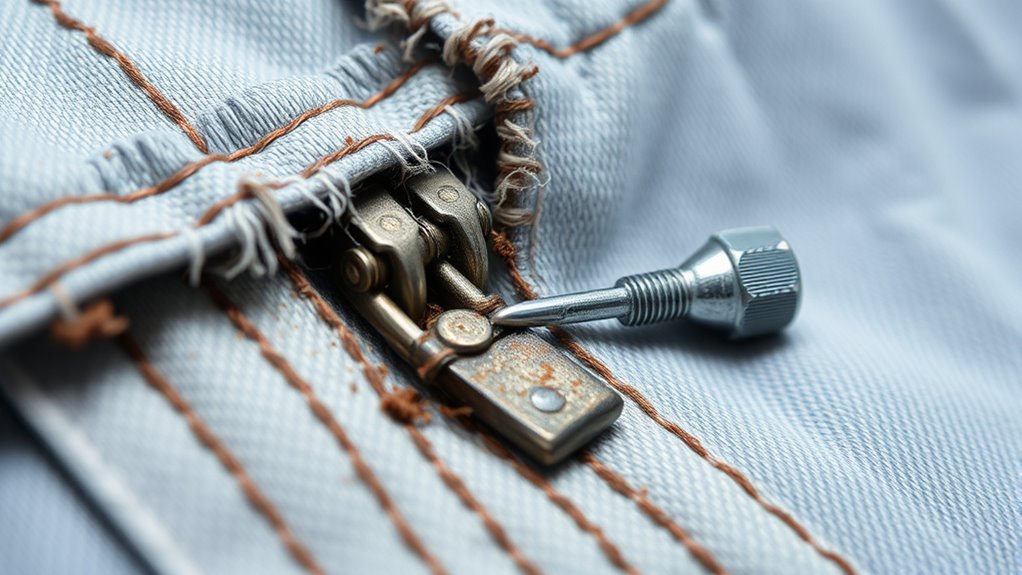
Many people assume zippers are beyond repair or replacement, but that’s not always true. Repair options are often overlooked, and in many cases, a skilled repair can considerably extend your zipper’s life. Sometimes, replacement isn’t necessary, saving you time and money.
Repair Options Often Overlooked
Even when it seems like a zipper can’t be repaired or replaced, there are still overlooked options worth exploring. Sometimes, the cover material can be repaired or reinforced to reduce stress on the zipper, extending its life. Additionally, you might consider a temporary fix like using a zipper stop or adding a zipper pull to improve functionality. If the damage is minor, a professional can often perform a specialized zipper replacement that preserves the cover’s integrity. Here are some options:
- Reinforcing the cover material around the zipper to prevent further damage.
- Applying a zipper repair kit for minor issues.
- Consulting an expert for precise zipper replacement that minimizes impact on the cover.
Exploring these alternatives can save you time and money, even when initial repairs seem impossible.
Replacement Is Not Always Necessary
Sometimes, replacing a zipper isn’t the only solution, especially if repair options seem unfeasible. Many believe in replacement myths, assuming a total zipper swap is always necessary. However, this isn’t true. Often, what seems like a damaged zipper can be fixed without an upgrade or complete replacement. You might be tempted to think an entire cover or cover upgrade is needed when a simple repair could restore functionality. Before jumping to unnecessary upgrades, consider alternative fixes like re-gluing or realigning the zipper. These small adjustments can extend the life of your cover and save you money. Remember, replacement isn’t always the answer—it’s worth exploring repair options first to avoid unnecessary expenses and prolong the lifespan of your cover.
Skilled Repairs Extend Lifespan
When repairs are beyond simple fixes, skilled professionals can still substantially extend the lifespan of your cover. They can address issues like zippers corrosion and cover discoloration, preventing further damage. Here’s how they help:
- Cleaning and treating zippers – Removing corrosion and applying protective coatings can keep zippers functioning smoothly, even if they can’t be replaced.
- Restoring fabric integrity – Professionals can repair minor tears and treat discoloration, delaying the need for full cover replacement.
- Sealing weak points – Reinforcing seams and repairs can prevent small issues from worsening, maintaining your cover’s protective qualities longer.
These expert interventions help you maximize your cover’s durability, saving money and effort over time.
Neglecting to Store Covers Properly When Not in Use
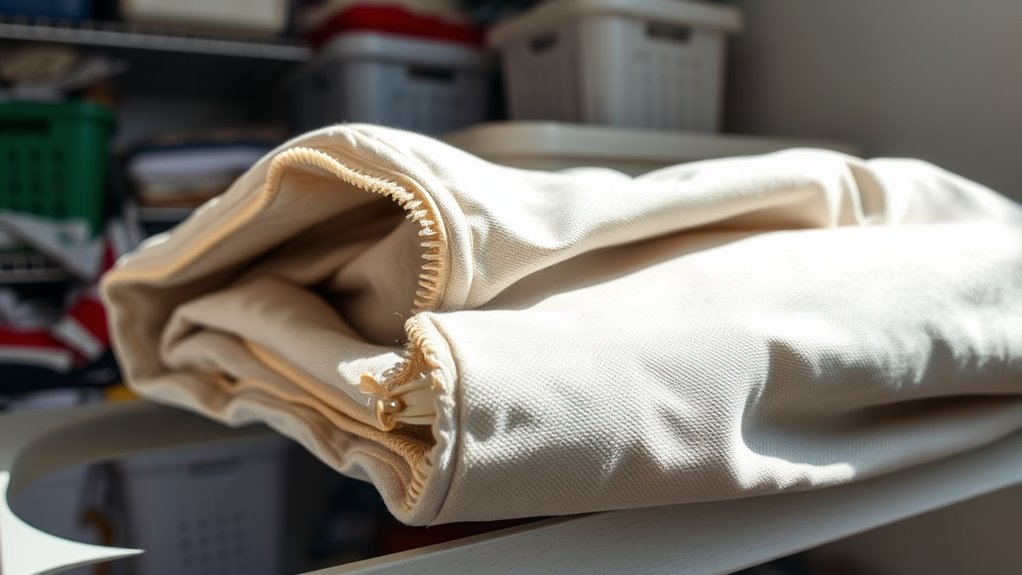
Neglecting to store zipper covers properly when they’re not in use can lead to unnecessary damage and reduced lifespan. Storage mistakes often stem from improper techniques, like cramming covers into tight spaces or leaving them exposed to dust and sunlight. These habits can cause fabric tears, fading, or zipper malfunctions over time. To prevent this, always fold covers neatly and store them in a cool, dry place away from direct sunlight. Avoid hanging covers on hooks, which can stretch or distort fabric. Use a designated container or drawer to keep covers organized and protected. Here’s a quick guide to proper storage:
| Mistake | Correct Technique | Result |
|---|---|---|
| Folding covers haphazardly | Fold neatly and flat | Maintains fabric integrity |
| Leaving covers exposed | Store in a container or drawer | Prevents dust and sunlight damage |
| Hanging covers loosely | Lay flat or hang properly | Prevents stretching |
| Using improper containers | Use breathable storage bags | Avoids moisture buildup |
| Ignoring storage conditions | Keep in cool, dry area | Extends cover lifespan |
Using Abrasive Tools or Scrubbing Too Hard During Cleaning
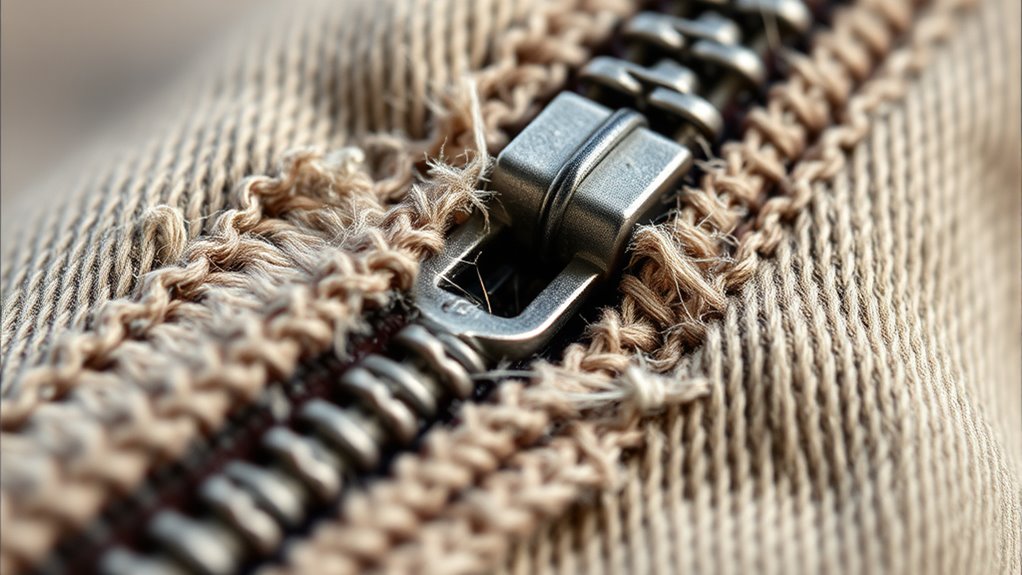
Proper storage helps protect zipper covers from damage, but how you clean them is equally important. Using abrasive tools or scrubbing too hard can cause abrasive damage that weakens the fabric and shortens its lifespan. To avoid this, keep these tips in mind:
- Steer clear of stiff brushes or scrub pads that can scratch or roughen the surface.
- Use gentle, circular motions instead of rough scrubbing to clean dirt or stains.
- Opt for soft cloths or sponges designed for delicate surfaces to prevent abrasive damage.
Assuming All Covers Are Suitable for Machine Washing
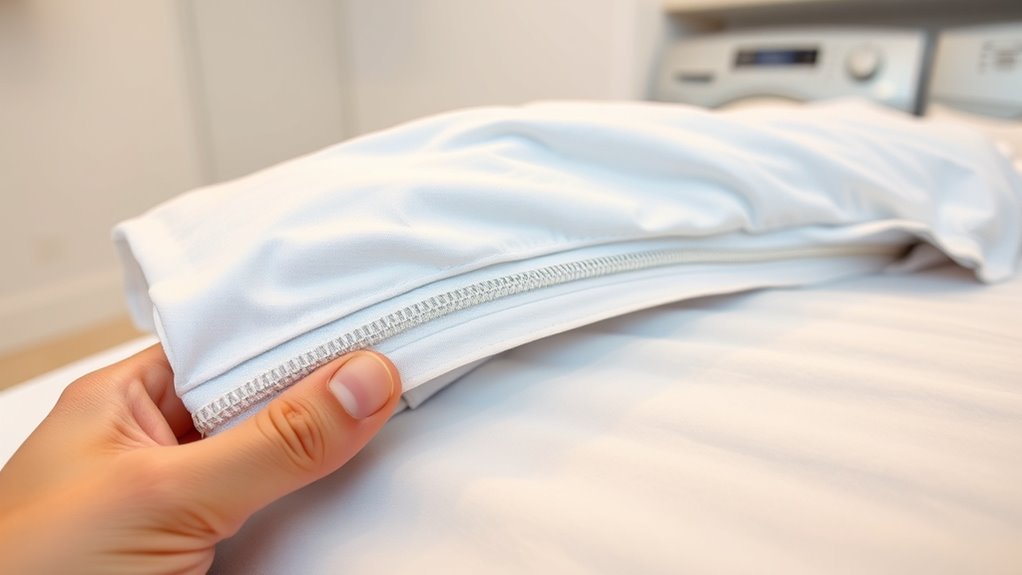
Not all zipper covers are safe to toss in the washing machine, so it’s important to check the care label first. Some covers may be delicate or made from materials that damage easily with machine washing. Using chemical cleaners or harsh detergents can also harm certain fabrics, so always follow manufacturer instructions. Relying on machine washing for stain removal isn’t always effective and can sometimes worsen stains or cause fabric deterioration. Instead, spot clean or hand wash if the label advises against machine cleaning. Remember, treating your cover with gentle care and avoiding unnecessary chemicals will help extend its lifespan. Always verify care instructions to make certain you don’t accidentally ruin your cover by assuming it’s machine washable.
Failing to Follow Manufacturer Recommendations for Care
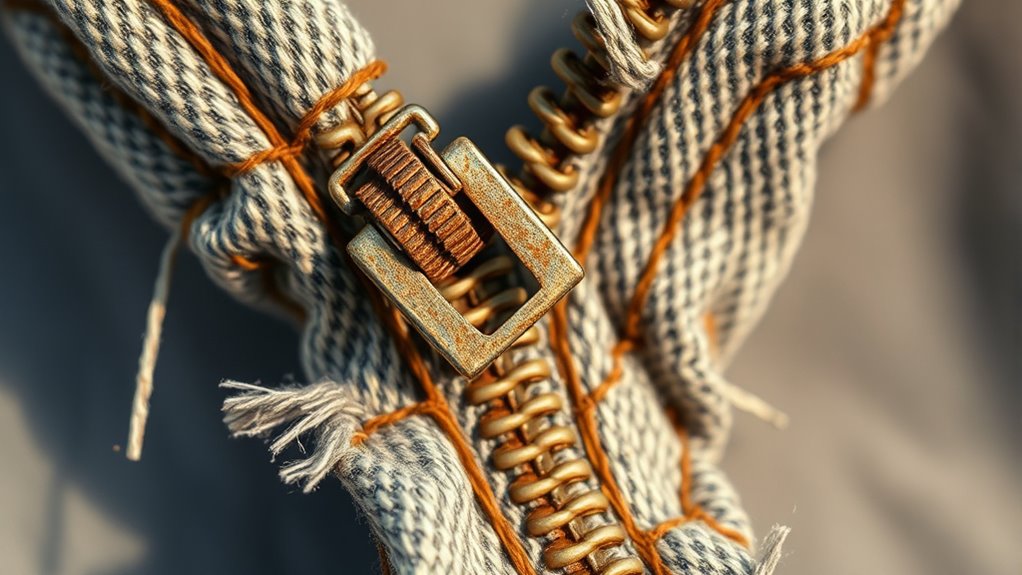
When you ignore the manufacturer’s care instructions, you risk damaging your zipper cover and shortening its lifespan. Following the manufacturer guidelines guarantees proper maintenance and helps your cover stay in good condition longer. Here are three common mistakes to avoid:
- Ignoring recommended washing temperatures, which can cause fabric damage or fading.
- Skipping specific drying instructions, risking shrinkage or material deterioration.
- Using harsh detergents that may weaken fabrics or affect zippers.
Overloading Washing Machines or Dryers When Cleaning Covers
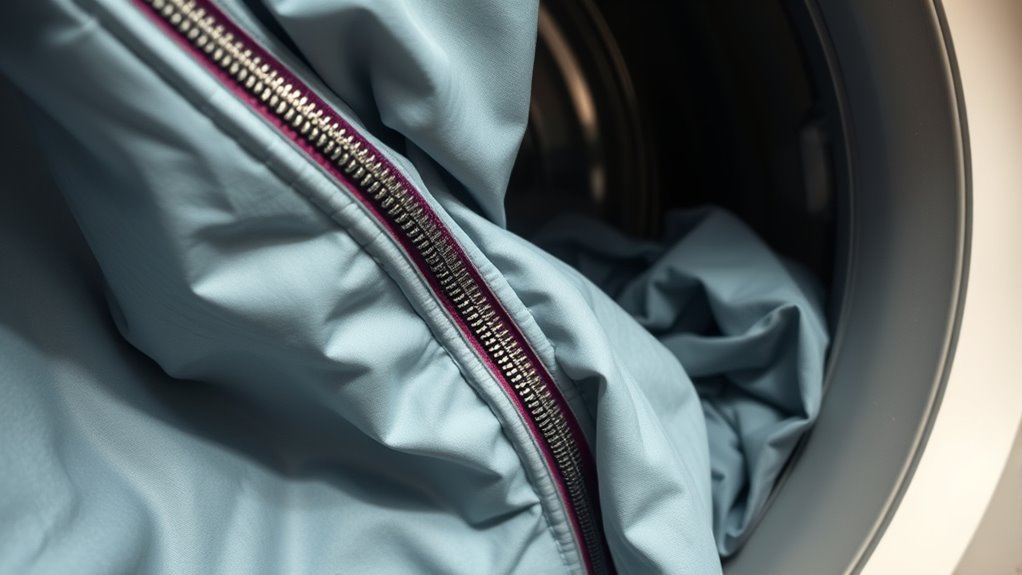
Overloading your washing machine or dryer can lead to inadequate cleaning and damage to your zipper cover. When you pack too many items in, the machine can’t move properly, resulting in uneven wash cycles and leftover dirt. This also increases the risk of machine overload, which strains the motor and damages internal parts. Additionally, an overloaded machine may cause chemical misuse, as you might use too much or too little detergent, reducing cleaning effectiveness or causing residue buildup. For best results, load your machine according to manufacturer guidelines, allowing enough space for water and soap to circulate. Proper loading prevents damage to your cover and ensures thorough cleaning, prolonging the life of both your zipper cover and your appliance.
Neglecting to Apply Protective Treatments or Sealants When Needed
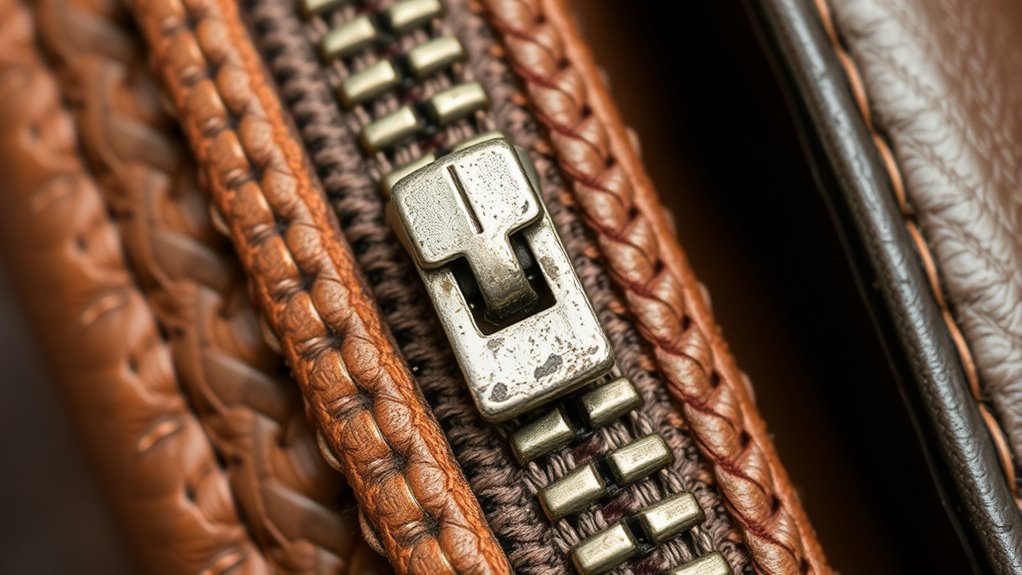
Applying protective treatments or sealants is essential to maintaining the durability of your zipper cover, especially in high-use or outdoor environments. Without proper protective coatings, your cover becomes vulnerable to moisture, dirt, and wear. Sealant application creates a barrier that prolongs its lifespan and preserves its appearance. Neglecting this step can lead to early deterioration and costly replacements. To ensure your cover stays in top condition:
- Regularly inspect for cracks or damage that need sealant touch-ups.
- Use appropriate protective coatings suited for outdoor or high-traffic areas.
- Reapply sealants periodically, especially after cleaning or exposure to harsh elements.
Frequently Asked Questions
How Often Should I Schedule Professional Inspections for Zippers and Covers?
You should schedule professional inspections for zippers and covers at least once a year, following a proper maintenance schedule. Inspection frequency depends on usage and environmental conditions; if you notice signs of wear or damage, get it checked sooner. Regular inspections help catch issues early, preventing costly repairs. Keep an eye on your covers and zippers, and don’t wait too long between professional assessments to ensure your items stay in top condition.
Are There Specific Signs Indicating a Zipper Needs Replacement?
If you notice a zipper malfunction like it sticking, splitting, or not closing properly, it’s a sign you might need a replacement. Also, check the cover material; if it’s torn, frayed, or shows significant wear, replacing the zipper can help maintain proper fit and function. Address these signs promptly to prevent further damage, ensuring your cover stays secure and effective for longer.
What Are the Best Storage Practices to Extend Cover Lifespan?
Think of your cover as a precious book—its longevity depends on proper care. Store it in a cool, dry place away from direct sunlight to prevent fading and material deterioration. Always keep the zipper clean and lubricated to avoid sticking. Folding it loosely prevents creases that weaken the fabric. Proper storage practices like these extend your cover’s lifespan, ensuring it stays functional and attractive for years to come.
Can Certain Cleaning Agents Damage Zipper Integrity?
Yes, certain cleaning chemicals can damage zipper integrity. Harsh cleaning chemicals, like bleach or strong solvents, can cause zipper deterioration over time. You should avoid using these on zippers and opt for mild, gentle cleaners instead. Proper cleaning and avoiding aggressive chemicals will help maintain your zipper’s functionality and extend its lifespan, ensuring your cover stays secure and effective longer.
How Do I Determine if My Cover’s Material Is Suitable for Machine Washing?
Ever wondered how to tell if your cover’s material is suitable for machine washing? You should check the washing instructions on the label; it provides essential info about cover material compatibility. If instructions are unclear or indicate hand wash only, avoid machine washing. Always follow the manufacturer’s guidelines to prevent damage. When in doubt, test a small area or contact the manufacturer for advice.
Conclusion
Don’t let myths and shortcuts sabotage your zipper and cover care. Think of your gear as a trusted friend—treat it with patience, respect, and the right knowledge. When you follow proper maintenance, you’re not just cleaning; you’re preserving durability and performance. Remember, a little care today prevents costly repairs tomorrow. So, are you ready to give your gear the love it deserves? Your future self will thank you—trust me, it’s worth it.
